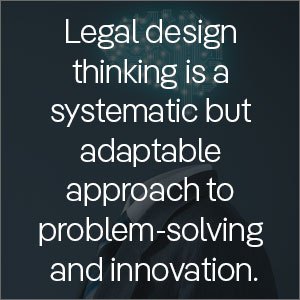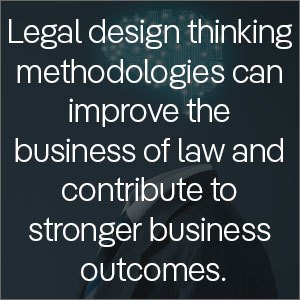It has always been the job of in-house corporate counsel to resolve problems. In fact, they create agreements, in the first place, to prevent problems much later on. In that way, corporate lawyers could be seen as being in the problem-solving and mitigation business. And yet, the industry has long been characterized by antiquated processes and outdated modes of ‘thinking.’ Not to mention a resistance toward technological change altogether.
“Invention (in the context of legal) is not the same as innovation,” Harvard Law School’s The Practice highlighted in January 2019. “The former is about creating something altogether new — where ‘newness,’ itself, is often viewed as the end goal — while the latter is about coming up with novel ideas and new ways of thinking with the express purpose of solving specific problems.”
Although this offers a fundamental comprehension of innovation, itself, questions around how to act on that understanding remain. Above all else, how do individuals and organizations, including in-house legal departments, actually do the important work of innovation?
Fortunately, there is a form of innovation that cuts across various legal issues and practice settings: legal design thinking. This simple methodology can be defined as a process that begins with clearly defining a problem and continues with searching for solutions — all without placing any restrictions on the process, itself. Legal design thinking encourages participants to brainstorm and think entirely out of the box. Next, it requires them to create, then test that creation, and then swiftly recreate the same. In other words, the notion of perfection is truly the ‘enemy of the good’ here. Legal design thinking is a lawyer’s means of finding a good enough place from which to build and enhance, and challenging some of their traditional beliefs and systems.
Knowing the Five Stages of Design Thinking
Although it came out of the industrial revolution, design thinking is a fairly new mindset and methodology. Herbert A. Simon, a cognitive scientist and Nobel Prize laureate, first offered ideas considered to be the principles of design thinking in his 1969 book, The Sciences of the Artificial. That lead to design thinking addressing human and technological needs in the 1970s. Today, in a number of industries and disciplines, it remains top of mind for business leaders. In fact, it is fast becoming one of the leading innovation methods.
By and large, design thinking is a systematic but adaptable approach to problem-solving and innovation. That is because it is equally human-centered, intentional, experimental, and responsive, as well as completely tolerant of failure, itself. You can view design thinking, then, as involving five distinct phases — empathize, define, ideate, prototype, and test:
- Empathize —The first phase allows for a better, more empathetic, understanding of the problem, pain points, needs, and emotions. (View this as a very solid beginning.)
- Define — The second phase is an opportunity to analyze and synthesize all of the information gathered during the first phase, before identifying and defining the core problem that needs to be solved. (Think of this as a ‘north star’ of sorts.)
- Ideate — The third phase is a chance to think outside of the proverbial box and look at a problem in alternative ways, before generating ideas based on the knowledge acquired during the first two phases. (Consider bringing together a cross-functional team to brainstorm.)
- Prototype — The fourth phase is a period to generate all of the various solutions to a problem, which has been explored during the first three stages. (Start to build here and remember to request plenty of feedback.)
- Test and refine — The final phase allows for the solutions identified in the previous phase to be tested. (Gather feedback and refine the solution as needed, even returning to the ideation phase.)
Applying Design Thinking to Legal
The application of design thinking mindsets and methodologies can significantly improve the business of law also, contributing to stronger business outcomes and helping corporate lawyers become strategic partners in companies. When it comes to this ‘legal design thinking,’ it is said that in the same way that you can “think like a lawyer,” you can most certainly “think like a designer.”
In 2013, Stanford University designers, technologists, and lawyers established the Legal Design Lab at Stanford Law School’s Center on the Legal Profession and Stanford University’s Institute of Design. They took a collaborative, multidisciplinary approach while experimenting with legal design and technology. As a matter of consequence, the Legal Design Lab created brand-new, user-centric legal products and services. It fully engaged, empowered, and equipped users in the “context of the legal ecosystem.”
Similar to the design thinking process noted above, legal design thinking entails identifying an issue, seeking the views of involved parties, and generating and testing ideas — as rapidly and iteratively as possible. Its benefits include user-centered innovation and new routes for legal work altogether, according to Margaret Hagan, the director of the Legal Design Lab. Hagan’s own legal design process, which is outlined in her e-book, Law by Design, involves:
- Identifying stakeholders, including the users
- Identifying the issues faced by users, along with their wants
- Brainstorming and developing various solutions
- Testing prototype solutions — and testing them yet again
- Evolving prototypes in response to ongoing feedback
Setting Legal Design Goals
With respect to the aims of legal design thinking, Hagan and the Legal Design Lab listed three possible goals:
- Working toward “incremental,” short-term improvements and “breakthrough” long-term change to assist legal professionals in the agile development of new products and services
- Building a better front- and back-end of a legal (management) system to improve the (digital) tools and interfaces with which people use and navigate
- Helping lay people and legal professionals to be smarter, more empowered — and in control of the complexities of legal matters and the laws that apply to them
Not surprisingly, modern legal design thinking is behind the most revolutionary legal management systems. It also helps corporate counsel address any legal task they need to deliver, whether it is buy-and-sell-side contracting, compliance requirements, or corporate governance.
Thinking About the Future of Legal Design Thinking
At the end of the day, corporate legal must improve not only its way of thinking, but also its everyday work processes. It has to come to grips with — and wholly embrace — disruptive forces like legal technology. It has to ask itself how it will react to such rapid, technological change — in the form of AI-based legal management systems mentioned above.
For many lawyers, the problem-solving methodology of legal design thinking is one of the most effective ways to answer this ‘big question.’ It brings together the potential of innovation, the needs of colleagues, and all of the requirements of business success. It combines what is the most desirable, from a human standpoint, with what is the most feasible, from a technological perspective. What is more, the legal design approach enables legal professionals to view particular problems through as many lenses as possible — to intelligently and flexibly solve the Gordian knots in-house legal faces today.
Want to learn more about ContractPodAi Cloud and the benefits of unified legal platforms? Check out our CLM Impact Research Report to find out how we can help streamline your own day-to-day workflows.
Author:

Sarvarth Misra
Connect with us on Linkedin





